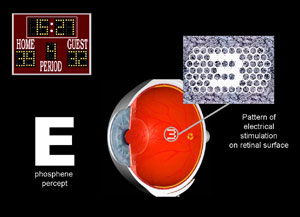Description of the Retinal Approach
Section of the eye showing the retina and its layers. In conditions such as retinitis pigmentosa and macular degeneration, the light sensing photoreceptors degenerate. However, the remaining cells (e.g. bipolar and ganglion) appear to respond to electrical stimulation and therefore remain potentially functional. The retinal prosthesis is designed to take over the function of the lost photoreceptors by electrically stimulating the remaining healthy cells of the retina. A retinal prosthesis can be placed either on the inner retinal surface ("epi-retinal") or below the retina in the area of damaged photoreceptors ("sub-retinal") to try to stimulate the remaining viable retinal cells.
A retinal-based neuroprosthesis is designed upon the premise that electrical stimulation of the remaining viable retinal cells evokes the sensation of discrete points of light (referred to as “phosphenes"). Given the highly organized architecture of the retina, presumably geometrical visual percepts can be generated by delivering appropriate multi-site patterns of electrical stimulation which in turn can lead to the perception of shapes and images. This strategy is similar to the effect of viewing an electronic scoreboard in a stadium (otherwise known as the “scoreboard approach”).


